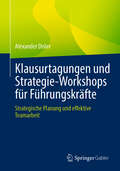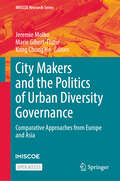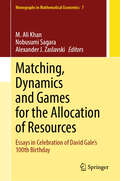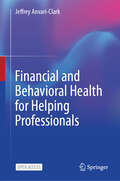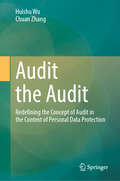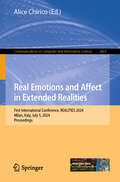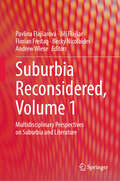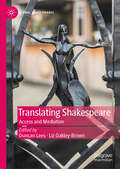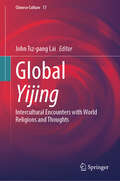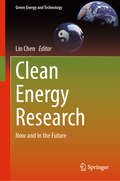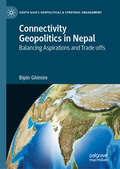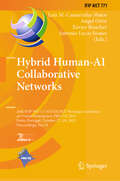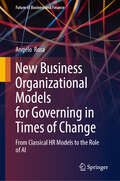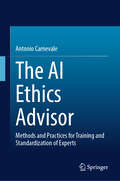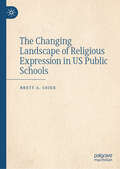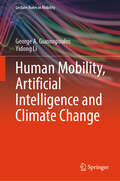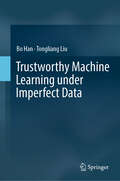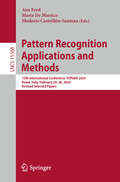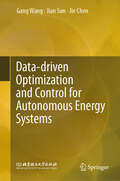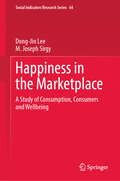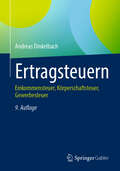- Table View
- List View
Klausurtagungen und Strategie-Workshops für Führungskräfte: Strategische Planung und effektive Teamarbeit
by Alexander DislerKlausurtagungen oder Strategie-Workshops sind für Unternehmen bewährte Formate, um strategisch wichtige Themen abseits des Tagesgeschäfts zu erarbeiten. Dieses Fachbuch bietet eine umfassende Schritt-für-Schritt-Anleitung, wie Sie herkömmliche Besprechungen in zielgerichtete Klausurtagungen und Workshops verwandeln, bei denen strategische Planung, Problemlösungen und Teamentwicklung im Vordergrund stehen. Erfahren Sie, wie Sie mit einer sorgfältigen Vorbereitung – von der Auswahl der Teilnehmer über die präzise Themenfindung bis zur optimalen logistischen Planung – den Grundstein für erfolgreiche Veranstaltungen legen. Über 20 praxisnahe Ideenfindungs-Methoden wie Brainstorming, SWOT-Analysen, Rollenspiele sowie über 10 interaktive Teamübungen unterstützen Sie dabei, Ihre Klausurtagungen oder Workshops strukturiert zu moderieren und auch herausfordernde Situationen souverän zu meistern. Inspirierende Fallbeispiele und zahlreiche Best Practices liefern wertvolle Impulse und zeigen, wie Klausurtagungen und Workshops die Zukunft Ihres Unternehmen aktiv gestalten. Das Buch richtet sich an Führungskräfte, Gründer:innen, Unternehmer:innen, Abteilungs- und Teamleitungen, Projektmanager:innen, Personalentwickler:innen, Berater:innen, Coaches und Organisationsentwickler:innen. Der Inhalt Definition und Zweck einer Klausurtagung oder eines Strategie-Workshops Vorbereitung und Durchführung Ablauf, Methoden und Best Practices: Einstieg, Hauptteil und Abschluss Ergebnisse und Nachbereitung Fallbeispiele und Erfahrungen
City Makers and the Politics of Urban Diversity Governance: Comparative Approaches from Europe and Asia (IMISCOE Research Series)
by Kong Chong Ho Marie Gibert-Flutre Jeremie MolhoThis open access book examines the rising challenges of managing diversity in European and Asian cities. It spotlights the roles of varied city makers - from urban leaders to migrant communities and civil society activists - in negotiating and transforming their city&’s diversity governance. The book brings together the contributions of urban studies and migration studies scholars, which offer rich empirical analyses on various European and Asian cities, such as Paris, Singapore, Barcelona, and Guangzhou. Adopting a comparative lens, the book presents a decentered understanding of 'super-diverse' cities, examining shifts in urban policy-making within different geographical contexts, with distinct patterns of migration and diversification. By advancing urban comparison as a research tool, it contributes to the contemporary discussions on the local turn of migration and diversity policies.
Matching, Dynamics and Games for the Allocation of Resources: Essays in Celebration of David Gale’s 100th Birthday (Monographs in Mathematical Economics #7)
by M. Ali Khan Alexander J. Zaslavski Nobusumi SagaraThis research book, dedicated to Professor David Gale on his 100th birthday, compiles significant new findings by renowned experts in mathematical economics related to Gale's work. The book is divided into three parts labelled as: "Economies and Games," "Economic Dynamics and Growth," and "Matching, Contracts, and Finance." These parts are introduced by the two surviving editors in an exploratory attempt to answer the question &“Who is David Gale?&” The first part contains 9 chapters covering topics such as visibility design in network games, repeated games with tail-measurable payoffs, the existence of calibrated forecasts via the minimax theorem, revealed preference theory, the problem of obtaining permission when options partially ordered, an alternative proof for the existence of Haar measures on locally compact topological groups, equilibria of nonlinear production-consumption models, systemic risk in financial networks, and coalitional transferable utility extensions of the Gale–Mas–Colell economy.The second part contains 7 chapters discussing topics like a generalization of the Pontryagin maximum principle in infinite horizon models, the Robinson–Shinkai–Leontief optimal growth model, dynamic CES production functions with a continuum of vintages of capital inputs across varying substitution elasticities, a two-country dynamic model, static and dynamic equilibrium in the Walrasian tradition, duality theorems in linear programming, and the turnpike phenomenon in the generalized von Neumann–Gale model.The third part comprises 4 chapters exploring the relationship between stable and weakly setwise stable outcomes in many-to-many matching with contracts, a version of Gale and Shapley&’s marriage market with a continuum of agents, the existence of stable contract systems between two complementary groups (e.g., workers and firms), and the general notions of upper and lower variances, initially introduced by Peter Walley for bounded random variables.
Financial and Behavioral Health for Helping Professionals
by Jeffrey Anvari-ClarkThis open access book brings together decades of research and practice on the intersections among financial and behavioral health concerns. By framing financial health as comprised of financial precarity, financial efficacy, and financial well-being, this new addition to the field of behavioral health helps readers understand and address the surge of interest in financial health and wellness from a holistic, psychosocial perspective. The text explores not only how financial difficulties impose hardship on individuals, couples, and families, but also how these concerns shape our feelings, perceptions, attitudes, and behaviors and thereby our health. Case examples throughout illustrate the concepts and provide a basis for engaging, assessing, and intervening. Beyond providing an overview of the financial domain of behavioral health from multiple theoretical frameworks, the chapters explore: Trauma, financial anxiety, and financial stressors affecting mental health Barriers to physical health care, financial toxicity, and medical debt Behavioral disorders including problem gambling and spending addiction Social relationship concerns involving financial enabling, infidelity, violence, and abuse A framework to guide professionals from basic financial awareness to client interventions Diagnostic and billing considerations to integrate financial concerns into clinical practice <li class="MsoNormal" style="mso-marg
Microbiota Profiling for Precision Medicine: Biomarker-Targeted Drug Delivery Strategies (Interdisciplinary Biotechnological Advances)
by Anurag Kumar Singh Santosh Kumar Singh Sachchida Nand Rai Emanuel VamanuThis book provides an in-depth exploration of microbiota profiling and precision medicine, including the underlying mechanisms, delivery methods, treatment strategies, and the impact of biomarker-targeted drug delivery. It incorporates the latest research findings, such as biomarker-targeted drug delivery, clinical assessment and diagnosis, and therapeutic approaches. The book offers a comprehensive overview of the latest developments in biomarker-targeted drug delivery strategies. It addresses the challenges faced by healthcare professionals, offering actionable strategies for effective multidisciplinary care, along with patient and family perspectives, coping mechanisms, and ways to improve quality of life. By combining scientific knowledge, clinical expertise, and patient insights, the book enhances understanding, diagnosis, and treatment options for these complex conditions. These qualities distinguish it from existing publications and make it a valuable resource for readers seeking a thorough and engaging overview of this subject. The chapters cover a broad range of topics, including recent advances in microbiota profiling techniques, microbiota's role in drug metabolism and toxicity, and its immunomodulatory effects. Special focus is given to the involvement of microbiota in neurodegenerative diseases such as Alzheimer's and Parkinson's, emphasizing the therapeutic potential of microbiome-targeted strategies. The authors provide expert analysis on integrating microbiota-derived data with innovative tools like nanotechnology and machine learning to improve drug delivery systems. Readers will also gain practical insights from case studies on microbiota-informed therapies for cancer, autoimmune conditions, and gastrointestinal disorders. This book is essential for researchers, clinicians, academicians, and students working in microbiome science, pharmacology, biotechnology, and precision medicine. It addresses key questions such as biomarker validation, data integration, and the ethical considerations necessary for the clinical use of microbiome-based therapies.
Audit the Audit: Redefining the Concept of Audit in the Context of Personal Data Protection
by Chuan Zhang Huishu WuThis book deals with the tension between law and technology of data protection topic, to propose a novel approach for interpreting personal data protection audit. Audits have long been criticized as &“a ritual of verification,&” originating from the financial sector. While this book proposed that audit is in fact a regulatory control system rather than a verification tool, especially dealing with audit of data. The prerequisite for reading this book is a basic understanding of data protection, audit system, information technology as well as administrative law.
Real Emotions and Affect in Extended Realities: First International Conference, REALITIES 2024, Milan, Italy, July 5, 2024, Proceedings (Communications in Computer and Information Science #2663)
by Alice ChiricoThis volume CCIS 2663 constitues the proceedings of the First International Conference on Real Emotions and Affect in Extended Realities, REALITIES 2024, held in Milan, Italy on July 5, 2024. The 12 full papers were carefully reviewed and selected from 30 submissions. These papers were organized in following topical sections: Emotions in Virtual and Transformative Natural Environments; Clinical and Psychological Applications in VR; AI, Video Games, and Emotions; Methodologies & Tools for Studying Emotions in VR; Virtual Emotions and Theoretical Concepts.
Suburbia Reconsidered, Volume 1: Multidisciplinary Perspectives on Suburbia and Literature
by Florian Freitag Andrew Wiese Pavlína Flajšarová Jiří Flajšar Becky NicolaidesThis 3-volume set examines how suburban spaces shape and reflect human experiences in North America, Europe, and Asia, bringing together works by an international group of scholars who explore suburbia through critical analyses of literature, culture, sociology, history, politics, and urban planning. The multidisciplinary and international scope of each volume offers readers a wide breadth of perspectives. Suburbia Reconsidered thus contributes significantly to the expanding field of suburban studies by offering novel insights into the representation of suburbs in literature, the cultural significance of suburban environments, and the socio-economic challenges confronting suburban communities across the globe. Volume 1 of this 3-volume set examines the depiction of suburban spaces in 20th- and 21st-century British, American, Canadian, and French literature. The contributors present original perspectives on how suburban environments influence human experiences and identities, as reflected in literature. Chapters in this section also probe the intersections of gender, race, and ethnicity within suburban fiction, and traverse popular genres from detective novels to memoirs. By integrating insights from literature, cultural studies, sociology, history, and urban planning, Suburbia Reconsidered enhances our understanding of suburban spaces and their potential for positive transformation, and encourages scholars to explore new methodologies and perspectives.
Translating Shakespeare: Access and Mediation (Global Shakespeares)
by Liz Oakley-Brown Duncan LeesThis edited collection explores the mediation between languages, cultures and people that occurs when Shakespeare is translated - in multiple senses - and who is included and excluded in the process. It features contributions from emerging and established critical and creative writers, who offer analysis of a wide range of global cases, spanning Asia, Latin America and the Middle East, as well as Europe and North America. The collection covers numerous languages, both spoken and written (including Dutch, Mandarin, Spanish, Tamil and Welsh), and visual (American Sign Language), and their uses across various multimodal contexts, from page and stage to film dubbing, radio plays and Netflix shows, and from classrooms to refugee camps.
Global Yijing: Intercultural Encounters with World Religions and Thoughts (Chinese Culture #17)
by John Tsz-pang LaiThis book is an examination of the globalization of the Yijing from cross-cultural and comparative perspectives, with a special focus on the Yijing encounters with world religions and thoughts over the past centuries. It presents an ambitious effort to bring together leading Yijing—The Book of Changes—scholars in the world. Composed of three parts and twelve chapters, it begins with a conceptualized narrative of the globalization of the Yijing, highlighting the intercultural encounters and transformation of the Yijing in different religious, philosophical, and cultural traditions across the globe. Part One investigates the interaction of the Yijing in Asian religions and philosophy including the Confucian and Buddhist traditions, as well as Maoism in Japan. Part Two explores how the Yijing was creatively and provocatively interpreted by Jesuit and Protestant missionaries, Chinese Christian intellectuals, and Chinese Islamic scholars from the Qing period to 20th century China. Part Three examines the multifaceted issues associated with the reception and transformation of the Yijing in Western thoughts, like French occultism, Carl Jung&’s analytical psychology and John Cage&’s experimental music theory and practice. This book is an essential reading for those who are interested in the Yijing and also serves as a useful reference for students and scholars of Chinese culture, Asian philosophy, East Asian studies, and translation studies.
Clean Energy Research: Now and in the Future (Green Energy and Technology)
by Lin ChenThis book provides readers with the latest developments and innovations in clean energy resources and systems, energy economics, and energy policies. Designed to help move towards a cleaner, more sustainable energy landscape, it offers theoretical insights, practical knowledge, and case studies on clean energy technology. It covers sustainable methods for increasing energy efficiency and examines current concepts and solutions to global energy storage and energy-saving issues, including wind energy technology and offshore potential, advanced solar energy systems and case studies, hydrogen production, storage, and material challenges, carbon capture, storage, and resource utilization, bioenergy and sustainable fuel innovations, energy system optimization, and thermal management. Clean Energy Research: Now and in the Future is an essential guide to up-to-date research results for scientists, practitioners, engineers, students, and researchers.
New Discoveries in the Brain Sciences of Fear and Anxiety - From Basic to Clinical Neuroscience (Current Topics in Behavioral Neurosciences #73)
by Mohammed R. Milad Jennifer Urbano BlackfordThis book focuses on the latest neuroscience findings about the neurobiology of fear and anxiety. Fear is a highly conserved and evolutionarily adaptive response to threats in the environment. Decades of research have identified the basic underlying neurocircuitry of fear and cutting-edge methods used in both animal models and humans continue to refine and shape our understanding of fear. While fear, when expressed in the appropriate context, is adaptive, excessive responses to threatening cues and contexts and anxiety are maladaptive. Fear-based disorders and anxiety disorders are highly prevalent and impairing. These disorders often begin in childhood, highlighting the importance of genetics, early environment, and risk factors. The contributors to this book are international experts in behavioral neuroscience, cognitive neuroscience, clinical neuroscience, psychiatry and psychology. Collectively, they provide diverse perspectives on the neurobiology of fear and anxiety. The invited contributions are organized to provide a critical review of the recent advances in the neuroscience research and will span the continuum from basic to clinical neuroscience with representation across species, development, and disorders. The sections of this book review the basic mechanisms underlying fear and anxiety, describe the factors that contribute to anxiety, including developmental stage, risk factors, sex differences, and genetics, elucidate how treatments work and describe novel treatments, and demonstrate the role of anxiety in other disorders including autism, substance use disorders, and schizophrenia. This critical and comprehensive collection of chapters will provide a review on the neuroscience of fear and anxiety that will be highly relevant for both scientists and clinicians interested in the brain mechanisms and associated psychopathologies related to fear and anxiety.
Connectivity Geopolitics in Nepal: Balancing Aspirations and Trade-offs (South Asia’s Geopolitical & Strategic Engagement)
by Bipin GhimireThis book is a critical articulation of Nepal&’s connectivity geopolitics, offering a triangular analysis of the country's geopolitics, connectivity and foreign policy. By elucidating the interplay between these elements, it contributes to a deeper understanding of how smaller states strategically balance aspirations and trade-offs in navigating the contemporary reality of connectivity geopolitics amidst competing global interests. Furthermore, it helps us examine how insights generated from a country's history of strategic culture could be valuable in navigating the contemporary reality of connectivity geopolitics and why one should not take foreign support for connectivity at face value. The
Esophageal Disorders: Diagnosis and Treatment
by Marco G. Patti Fernando A. M. Herbella Francisco SchlottmannThis book is a state-of-the-art description of the pathophysiology, diagnosis and treatment of benign esophageal disorders. Expert physicians provide an evidence- and experience-based analysis in each chapter. Written for a readership which includes primary care physicians, internal medicine doctors, gastroenterologists, pulmonologists, surgeons, as well as medical students. As easy-to-read yet comprehensive and detailed book, with clear information.
Hybrid Human-AI Collaborative Networks: 26th IFIP WG 5.5 SOCOLNET Working Conference on Virtual Enterprises, PRO-VE 2025, Porto, Portugal, October 27-29, 2025, Proceedings, Part II (IFIP Advances in Information and Communication Technology #771)
by Luis M. Camarinha-Matos Angel Ortiz Xavier Boucher Antonio Lucas SoaresThis two-volume set, IFIP AICT 770-771, constitutes the refereed proceedings of the 26th IFIP WG 5.5 SOCOLNET Working Conference on Virtual Enterprises on Hybrid Human-AI Collaborative Networks, PRO-VE 2025, held in Porto, Portugal, during October 27-29, 2025. The 60 full papers were carefully reviewed and selected from 126 submissions. These papers are organized around the following main topics: · Society 5.0, AI as a driver for Collaboration, Collaborative Risk and Crisis Management, AI for Logistics and Supply Chain, Technologies for Adaptable Collaborative Networks, People-Centered and AI-driven Processes, Multi-agent Systems for Hybrid Human-AI Collaboration, <span lang="EN-US" style="font-size: 12.0pt; f
New Business Organizational Models for Governing in Times of Change: From Classical HR Models to the Role of AI (Future of Business and Finance)
by Angelo RosaThis book explores transformation of organizational structures and governance in a VUCA world, with a particular focus on artificial intelligence (AI). In an era characterized by globalization, technological upheavals and climate change, traditional human resources practices and classical management models show obvious limitations. AI emerges as a transformative force, redefining work through human-AI collaboration, role rewriting and necessary retraining. This book critiques outdated management paradigms, analyzes the integration of AI into governance models, and explores the evolving relationship between humans and machines to provide a roadmap for organizations. The author provides an assessment of how AI is transforming the workplace and offers actionable strategies for organizations to navigate this changing landscape. The author also provides a system for human-centric, ethical integration of AI into today&’s work environment.
Unconventional Organisms in Biotechnology (Advances in Biochemical Engineering/Biotechnology #192)
by Dirk HoltmannThis book reviews the potential of unconventional production organisms in biotechnology, emphasizing their role in enhancing bioprocess efficiency and sustainability. By focusing on a diverse range of microorganisms, such as the archaea Methanothermobacter thermautotrophicus and the fast-growing bacterium Vibrio natriegens, the book highlights the opportunities and needs for integrating these organisms into biotechnological applications. The chapters cover topics such as the utilization of alternative substrates like CO2 and methane, adaptation to unusual process conditions, and the exploitation of microbial diversity for enhanced biofilm growth and electron transport systems. Each chapter begins with an overview of the microbiological and biochemical characteristics of the organisms, followed by discussions on their biotechnological applications. Readers will also find expert analysis of the current challenges and future trends in the application of these organisms, making the book a must-read for anyone interested in advancing bioprocess technologies. Given its breadth, this book is an invaluable resource for researchers, scholars, and practitioners in biotechnology and related fields. It provides cutting-edge insights into the development of processes based on alternative organisms, and their role in shaping the future of biotechnology.
The AI Ethics Advisor: Methods and Practices for Training and Standardization of Experts
by Antonio CarnevaleThis book addresses a crucial and timely question: who will evaluate the ethical practices of increasingly intelligent AI systems, and what qualifications will they need to ensure those ethics are applied responsibly? As AI systems become more capable of fostering trust in human-machine interactions, developers and data scientists are becoming more aware of the importance of programming ethical and non-discriminatory algorithms. Simultaneously, laws may soon require companies to continuously assess the social and ethical impacts of their AI products. But who will oversee these evaluations, and how can we prevent ethics from being distorted or misused? Rather than focusing on how ethical principles should be applied to AI, this book takes a unique approach by exploring the role of the 'ethics officer'—the individual responsible for ensuring an AI system's ethical compliance. With AI regulation gaining momentum across the globe, ethics is becoming a critical component of international technology leadership, and this book provides insight into these critical questions, exploring how the role of the ethics officer might evolve as AI becomes more pervasive and regulated, and what it will take to ensure that AI serves society ethically and responsibly.
The Changing Landscape of Religious Expression in US Public Schools
by Brett A. GeierThis book explores the intersection of issues related to religion and state in public schools in the United States. Framed through a study of the landmark 2022 Supreme Court case Kennedy v. Bremerton School District, where a high school football coach's post-game prayers at midfield became the centerpiece of a major ruling on religious expression in public schools, the book analyzes how this case represents a significant shift in the Supreme Court's interpretation of the Establishment Clause, particularly under the Roberts Court, which has increasingly favored religious freedom claims over strict separation of church and state. Through eleven chapters, Geier explores the historical context of religion in American public schools, the rise and fall of the Lemon test, the influence of Christian Nationalism, and provides a detailed analysis of both the majority opinion written by Justice Gorsuch and the dissent by Justice Sotomayor. Drawing from his experience as a public school administrator and legal researcher, Geier argues that this ruling signals a new era where individual religious rights are being prioritized over Establishment Clause concerns in public schools, potentially leading to increased religious expression in educational settings.
Human Mobility, Artificial Intelligence and Climate Change (Lecture Notes in Mobility)
by George A. Giannopoulos Yidong LiThis monograph offers a comprehensive discussion on the current challenges for developing future sustainable and resilient transport systems. It specifically focuses on the effects of two major shaping factors, namely climate change and the increased use of technologies, in particular artificial intelligence. It analyses issues and the relevant strategies adopted by different governments for facing social and environmental issues while planning the intelligent and decarbonized mobility of the future. Topics discussed in this book include: the use of artificial intelligence and big data in transportation and mobility, strategies for decarbonizing transport, the role of automated transport in future mobility, resilient transport infrastructures and other important related issues. Besides addressing researchers and professionals active in this field, this book will also offer an introduction on achievements and future challenges in mobility for newcomers.
Trustworthy Machine Learning under Imperfect Data
by Tongliang Liu Bo HanThe subject of this book centresaround trustworthy machine learning under imperfect data. It is primarily designed forscientists, researchers, practitioners, professionals, postgraduates andundergraduates in thefield of machine learning and artificial intelligence. The book focuseson trustworthy deep learning under various types of imperfect data, includingnoisy labels, adversarial examples, and out-of-distribution data. It coverstrustworthy machine learning algorithms, theories, and systems. The main goal of the book is to provide students and researchers in academia with anunbiased and comprehensive literature review. More importantly, it aims to stimulateinsightful discussions about the future of trustworthy machine learning. By engaging the audiencein more in-depth conversations, the book intends to spark ideas for addressing coreproblems in this topic. For example, it will explore how to build up benchmark datasets innoisy-supervised learning, how to tackle the emerging adversarial learning, andhow to tackle out-of-distribution detection. For practitioners in the industry,this book will present state-of-the-art trustworthy machine learning methods tohelp them solve real-world problems in different scenarios, such as onlinerecommendation and web search. While the book will introduce the basics ofknowledge required, readers will benefit from having some familiarity withlinear algebra, probability, machine learning, and artificial intelligence. Theemphasis will be on conveying the intuition behind all formal concepts,theories, and methodologies, ensuring the book remains self-contained at a highlevel.
Pattern Recognition Applications and Methods: 13th International Conference, ICPRAM 2024, Rome, Italy, February 24–26, 2024, Revised Selected Papers (Lecture Notes in Computer Science #15568)
by Ana Fred Maria De Marsico Modesto Castrillón-SantanaThis book constitutes the thoroughly refereed and revised selected papers from the 13th International Conference on Pattern Recognition Applications and Methods, ICPRAM 2024, held in Rome, Italy, during February 24-26, 2024. The 6 full papers and 4 short papers included in this book were carefully reviewed and selected from 139 submissions. They were organized in topical sections as follows: theory and methods; and applications.
Data-driven Optimization and Control for Autonomous Energy Systems
by Jie Chen Jian Sun Gang WangThis book introduces a pioneering framework for monitoring and controlling autonomous energy systems, distinguished by its use of physics-informed deep neural networks. These networks provide accurate estimations and forecasts, interlacing with advanced composite optimization algorithms to simplify the complex processes of state estimation. This approach not only boosts operational efficiency but also maximizes flexibility through a data-driven methodology integrated with physics-based principles. The framework leverages the power of neural networks to define the intricate relationship between system states and control policies, offering precise, robust control strategies that adapt to dynamically changing system conditions. This book is essential reading for professionals looking to enhance the performance and flexibility of energy systems through cutting-edge technology.
Happiness in the Marketplace: A Study of Consumption, Consumers and Wellbeing (Social Indicators Research Series #64)
by M. Joseph Sirgy Dong-Jin LeeThis book provides a systematic review and analysis of the literature on product-related, situational, organizational, and cultural factors influencing people’s happiness in the marketplace. The authors, senior experts in the field, make specific recommendations to design and implement consumer wellbeing strategies. These recommendations are for marketing executives to maximize their effectiveness and help consumers achieve optimal levels of happiness (overall happiness, consumer happiness, and consumption happiness), which in turn could enhance organizational return on investment through customer loyalty, repeat patronage, sales, and profit. The book reviews and integrates learnings from the research on happiness in several fields of study, namely, quality-of-life studies, marketing, consumer studies, social psychology, and behavioral economics, and is of interest to marketing executives and academics from various fields working on consumers and consumer wellbeing.
Ertragsteuern: Einkommensteuer, Körperschaftsteuer, Gewerbesteuer
by Andreas DinkelbachDieses Grundlagen- und Vertiefungswerk für Ausbildung, Studium und Praxis im Steuerrecht bietet einen kompakten, systematischen Einstieg in alle wesentlichen Bereiche der Ertragsteuern und bereitet den Stoff bis zur Vorbereitung auf das StB-Examen auf. Von A wie Abgeltungsteuer über O wie Organschaft bis Z wie Zinsschranke werden alle relevanten Aspekte der Ertragsteuern für natürliche und juristische Personen systematisch verständlich erläutert. Einen besonderen Schwerpunkt bildet die Besteuerung von Einzelunternehmen, Personen- und Kapitalgesellschaften. Über die Darstellung der Besteuerungsprinzipien und Einzelregelungen hinaus, die durch fast 160 Abbildungen und zahlreiche Beispiele sehr anschaulich illustriert werden, beantwortet das Lehrbuch stets auch die Frage nach dem „Warum?&“ steuerlicher Regelungen. Ein fundiertes Verständnis der steuerlichen Regelungen und Zusammenhänge ist damit garantiert. Die umfassende Aktualisierung auf den Rechtsstand 2025 berücksichtigt alle bis Mai 2025 verabschiedeten Änderungsgesetze sowie die aktuelle Rechtsprechung und Verwaltungsmeinung.
